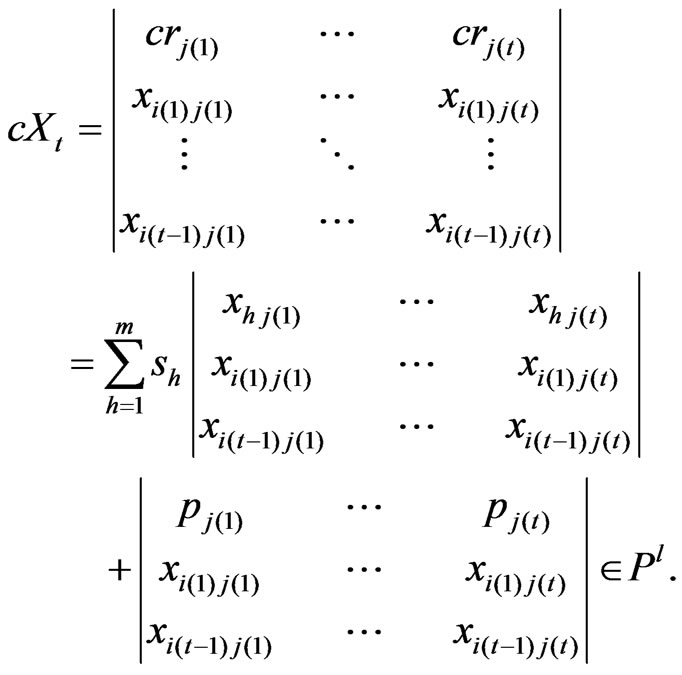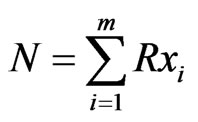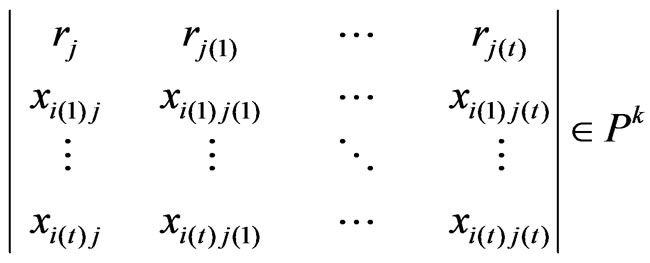Advances in Pure Mathematics
Vol.2 No.5(2012), Article ID:22803,5 pages DOI:10.4236/apm.2012.25049
The Primary Radical of a Submodule
University College, Abu Dhabi Universityn, Abu Dhabi, UAE
Email: lamis_jomah@yahoo.com
Received April 5, 2012; revised April 29, 2012; accepted May 7, 2012
Keywords: Primary submodule; prime radical of a submodule; radical submodule; free module; Noetherian module; finitely generated submodule
ABSTRACT
In this paper we introduced a definition for the primary radical of a submodule with some of its basic properties. We also define the P-radical submodule and review some results about it. We find a method to characterize the primary radical of a finitely generated submodule of a free module.
1. Introduction
The prime radical of a submodule  of an R-module
of an R-module , denoted by
, denoted by  is defined as the intersection of all prime submodules of
is defined as the intersection of all prime submodules of  which contain
which contain , if there exists no prime submodule of
, if there exists no prime submodule of  containing
containing , we put
, we put  [1].
[1].
We naturally seek a counterpart in the primary radical of a submodule of module.
Firstly we introduced a definition for the primary radical of a submodule with some of its basic properties. We also define the P-radical submodule and review some results about it.
Finally, we find a method to characterize the primary radical of a finitely generated submodule of a free module.
2. Some Basic Properties of the Primary Radical
In this section we introduce the concept of the primary radical and give some useful properties about it.
2.1. Definition
The primary radical of a submodule  of an R-module
of an R-module , denoted by
, denoted by  is defined as the intersection of all primary submodules of
is defined as the intersection of all primary submodules of  which contain
which contain . If there exists no primary submodule of
. If there exists no primary submodule of  containing
containing , we put
, we put .
.
If , since the primary submodules and the primary ideals are the same, so if
, since the primary submodules and the primary ideals are the same, so if  is an ideal of
is an ideal of ,
,  is the intersection of all primary ideals of
is the intersection of all primary ideals of , which contain
, which contain . Now, we give useful properties of the primary radical of a submodule.
. Now, we give useful properties of the primary radical of a submodule.
2.2. Proposition
Let  and
and  be submodules of an R-module
be submodules of an R-module . Then 1)
. Then 1) 
2) 
3) 
Proof.
1) It is clear.
2) Let  be primary submodule of
be primary submodule of  containing L,
containing L,
since  so
so . Thus
. Thus .
.
By the same way  .
.
It follows  .
.
3) By 1) we have . Now
. Now  where the intersection is over all primary submodules
where the intersection is over all primary submodules  of
of  with
with .
.

In the following two propositions, we give a condition under which the other inclusion of 2) holds, that is;  provided that every primary submodule of
provided that every primary submodule of  which contains
which contains  is completely irreducible submodule. Where a submodule
is completely irreducible submodule. Where a submodule  of an
of an  -module
-module  is called Completely Irreducible if whenever
is called Completely Irreducible if whenever , then either
, then either  or
or  where
where  and
and  are submodules of
are submodules of .
.
2.3. Proposition
Let  and
and  be submodules of an
be submodules of an  -module
-module . If every primary submodule of
. If every primary submodule of  which contains
which contains  is completely irreducible submodule, then:
is completely irreducible submodule, then:
 .
.
Proof. By proposition (2.2, (2))  . If
. If , clearly
, clearly  . If
. If , there exists a primary submodule
, there exists a primary submodule  of
of  such that,
such that,  by hypothesis either
by hypothesis either  or
or  so that either
so that either  or
or , because every primary submodule containing
, because every primary submodule containing , so either
, so either  or
or  therefore
therefore  .
.
2.4. Proposition
Let  and
and  be submodules of an
be submodules of an  -module
-module 
such that , then
, then
 .
.
Proof. If  is a primary submodule containing
is a primary submodule containing , then
, then . So
. So
 .
.
Since is a prime ideal, either
is a prime ideal, either
 or
or .
.
If ,
,
then  for otherwise
for otherwise  which is a contradiction. Therefore
which is a contradiction. Therefore . Now, applying proposition (2.3), we can conclude that
. Now, applying proposition (2.3), we can conclude that
 .
.
We conclude the same result if .
.
Let  be a proper submodule of an R-module
be a proper submodule of an R-module . Let
. Let  be a prime ideal of R. For each positive integer
be a prime ideal of R. For each positive integer , we shall denote by
, we shall denote by  the following subset of
the following subset of

2.5. Proposition
Let  be a submodules of an R-module
be a submodules of an R-module  and
and  be a prime ideal of R. For each positive integer
be a prime ideal of R. For each positive integer :
:  or
or  is a
is a  -primary submodule of
-primary submodule of .
.
Proof. Let  be any positive integer, it is clear that
be any positive integer, it is clear that
 is a submodule of
is a submodule of .
.
Assume . To show
. To show  is
is  -primary,
-primary,  that is
that is . Nowlet
. Nowlet  be a submodule of
be a submodule of  properly containing
properly containing , let
, let ,
, .
.
Since , let
, let , but
, but  thus
thus , there exists
, there exists  such that
such that
 . If
. If , then
, then  and this implies
and this implies , which is a contradiction. It follows
, which is a contradiction. It follows , therefore
, therefore .
.
So  is a primary submodule
is a primary submodule
 , we have proved above that
, we have proved above that
 , that is
, that is .
.
Let ,
,  for some
for some , thus
, thus  for some
for some . If
. If  then
then  this implies
this implies , which is a contradiction. Therefore
, which is a contradiction. Therefore  thus
thus
 .
.
The following theorem gives a description of the primary radical of a submodule.
2.6. Theorem
Let  be a submodule of a module
be a submodule of a module  over a Noetherian ring
over a Noetherian ring . Then
. Then

Proof. By proposition (2.2), for each positive integer  and any prime ideal
and any prime ideal  we have
we have  is a
is a  -primary submodule containing
-primary submodule containing . Hence
. Hence

For every primary submodule  containing
containing  with
with
 there exists a positive integer
there exists a positive integer  such that
such that . So
. So

Thus

We will give the following definition.
2.7. Definition
A proper submodule  of an R-module
of an R-module  with
with  will be called P-Radical Submodule.
will be called P-Radical Submodule.
Now, we are ready to consider the relationships among the following three statements for any r-module .
.
1)  satisfies the ascending chain condition for pradical submodules.
satisfies the ascending chain condition for pradical submodules.
2) Each p-radical submodule is an intersection of a finite number of primary submodules 3) Every p-radical submodule is the p-radical of a finitely generated submodule of it.
2.8. Proposition
Let  be an
be an  -module. If
-module. If  satisfies the ascending chain condition for p-radical submodule of
satisfies the ascending chain condition for p-radical submodule of  is an intersection of a finite number of primary submoules.
is an intersection of a finite number of primary submoules.
Proof. Let  be a p-radical submodule of
be a p-radical submodule of  and put
and put , where
, where  is a primary submodule for each
is a primary submodule for each , and the expression is reduced. Assume that
, and the expression is reduced. Assume that  is an infinite index set. Without loss of generality we may assume that
is an infinite index set. Without loss of generality we may assume that  is countable, then
is countable, then
 is an ascending chain of p-radical submodules, since by proposition (2.2),
is an ascending chain of p-radical submodules, since by proposition (2.2),

By hypothesis this ascending chain must terminate, so there exists  such that
such that , whence
, whence  which contradicts that the expression
which contradicts that the expression  is a reduced. Therefore
is a reduced. Therefore  must be finite.
must be finite.
2.9. Proposition
Let  be an r-module. If
be an r-module. If  satisfies the ascending chain condition for p-radical submodules, then every p-radical submodule is the p-radical of finitely generated submodule of it.
satisfies the ascending chain condition for p-radical submodules, then every p-radical submodule is the p-radical of finitely generated submodule of it.
Proof. Assume that there exists a p-radical submodule  of
of  which is not the p-radical of a finitely generated submodule of it. Let
which is not the p-radical of a finitely generated submodule of it. Let  and let
and let
 so
so , hence there exists
, hence there exists
 . Let
. Let , then
, then
 , thus there exists
, thus there exists , etc. This implies an ascending chain of p-radical submodules,
, etc. This implies an ascending chain of p-radical submodules,
 which does not terminate and this contradicts the hypothesis.
which does not terminate and this contradicts the hypothesis.
2.10. Proposition
Let  be a finitely generated r-module. If every primary submodule of
be a finitely generated r-module. If every primary submodule of  is the p-radical of a finitely generated submodule of it, then
is the p-radical of a finitely generated submodule of it, then  satisfies the ascending chain condition for primary submodules.
satisfies the ascending chain condition for primary submodules.
Proof. Let  be an ascending chain of primary submodules of
be an ascending chain of primary submodules of . Since
. Since  is finitely generated then,
is finitely generated then,  is a primary submodule of
is a primary submodule of .
.
Thus by hypothesis,  is the p-radical for some finitely generated submodule
is the p-radical for some finitely generated submodule , hence
, hence , then there exists
, then there exists  such that
such that  hence
hence
 . Thus
. Thus  for some
for some . Therefore the chain of primary submodules
. Therefore the chain of primary submodules  terminates
terminates
3. The Primary Radical of Submodules of Free Modules
In this section we describe the elements of , where
, where  is a finitely generated submodule of the free module
is a finitely generated submodule of the free module . Let
. Let  be a positive integer and let
be a positive integer and let  be the free
be the free  -module
-module .
.
Let  for some
for some , then
, then  ,
,  , for some
, for some ,
,  ,
, .
.
We set

Thus the jth row of the matrix  consists of the components of the element
consists of the components of the element  in
in . Let
. Let .
.
By a  minor of
minor of  we mean the determinant of a
we mean the determinant of a  submatrix of
submatrix of , that is a determinant of the form:
, that is a determinant of the form:

where ,
, . For each
. For each .
.
We denote by  the ideal of
the ideal of  generated by the
generated by the  minors of
minors of .
.
Note that , where
, where .
.
The key to the desired result is the following two propositions.
3.1. Proposition
Let  be a ring and
be a ring and  be the free
be the free  -module
-module , for some positive integer
, for some positive integer . Let
. Let  be a finitely generated submodule of
be a finitely generated submodule of  where
where . If
. If , then
, then  in
in

Proof. Suppose  where
where ,
, . Let
. Let  be any maximal ideal of
be any maximal ideal of  and
and  such that
such that . By proposition (2), there exists
. By proposition (2), there exists ,
,  ,
,  and
and  such that
such that , where
, where , that is, if
, that is, if  where
where 
 , then 3.1)
, then 3.1) 
Suppose that
 ,
,

Let

which is a  minor of
minor of . Then by (3.1)
. Then by (3.1)

which is primary with  (note that, here
(note that, here
 ) hence
) hence . It follows
. It follows  for every maximal ideal
for every maximal ideal  with
with  for some
for some  and
and
 .
.
3.2. Proposition
Let  be a ring and
be a ring and  be the free
be the free  -module
-module for some positive integer
for some positive integer . Let
. Let  be a finitely generated submodule of
be a finitely generated submodule of  where
where . If
. If  in
in

 , then
, then .
.
Proof. Suppose

and . Let
. Let  be any prime ideal of
be any prime ideal of  and
and  any positive integer. It is enough to show that
any positive integer. It is enough to show that  for all
for all .
.
If , then
, then
 , hence
, hence
 Suppose SSS
Suppose SSS
 .
.
Note that 
Thus there exists  such that
such that  but
but  is a subset of
is a subset of , there exists
, there exists  , such that
, such that

By hypothesis, for each 

Expanding this determinant by first column we find that  where
where

For each 
Note that  and
and  are independent of
are independent of . Thus
. Thus

i.e.  with
with  , hence
, hence .Thus
.Thus .
.
3.3. Proposition
Let  and
and  be
be  -modules and
-modules and

Let  be a proper submodule of
be a proper submodule of ,
,
then  if and only if
if and only if .
.
Proof: Suppose first that . Let
. Let  be any primary submodule of
be any primary submodule of  such that
such that . Let
. Let .
.  is a submodule of
is a submodule of  and if
and if  then
then  is a primary submodule of
is a primary submodule of  since, if
since, if  where
where  and
and , then
, then , which is primary submodule of
, which is primary submodule of , hence either
, hence either  thus
thus  or
or  for some
for some  that is,
that is,
 , so
, so  , therefore
, therefore
 , thus
, thus  for some
for some , that is
, that is . Hence
. Hence  is a primary submodule of
is a primary submodule of  containing
containing . Thus
. Thus , so
, so . It follows
. It follows  Conversely, suppose that
Conversely, suppose that . Let
. Let  be a primary submodule of
be a primary submodule of  such that
such that . Then
. Then  is a primary submodule of
is a primary submodule of  containing
containing . Hence
. Hence , that is
, that is 
Now, we have the main result of this section.
3.4. Theorem
Let  be a ring and
be a ring and  be the free
be the free  -module
-module , for some positive integer
, for some positive integer . Let
. Let  be a finitely generated submodule of
be a finitely generated submodule of  where
where . If
. If , then
, then  in
in

 .
.
Proof. Let . Suppose first
. Suppose first , that is
, that is , by proposition (3.1), if
, by proposition (3.1), if , then
, then  in
in

 .
.
Now suppose  i.e.
i.e. . Let
. Let 
 for some
for some  and
and ,
, . By proposition (3.3),
. By proposition (3.3),  if and only if
if and only if  in
in . Where
. Where

Now apply proposition (3.1) to obtain the result.
The following example will illustrate application of the proposition (3.2).
3.5. Example
Let  and
and  be the submodule
be the submodule
 of
of . Then
. Then
 if
if  in 2Z and
in 2Z and .
.
REFERENCES
- R. L. McCasland and M. E. Moore, “On Radicals of Submodules of Finitely Generated Modules,” Canadian Mathematical Bulletin, Vol. 29, 1986, pp. 37-39.

